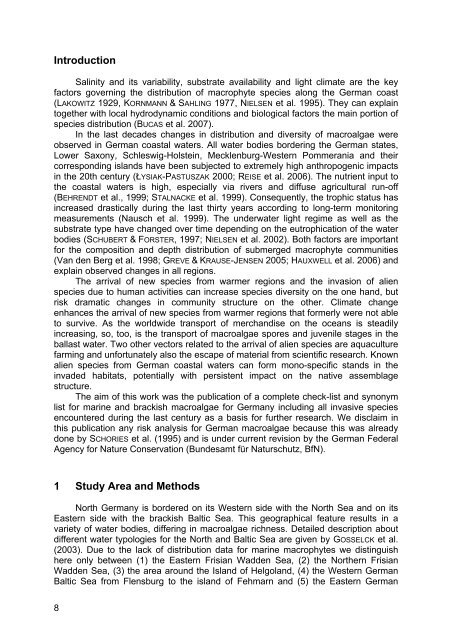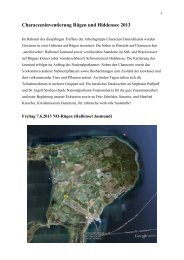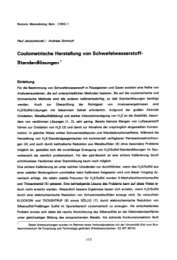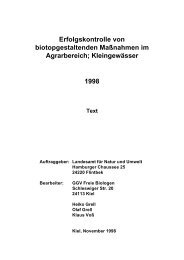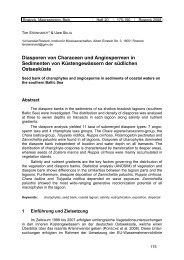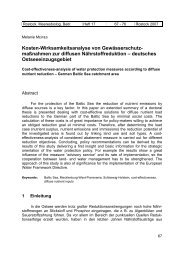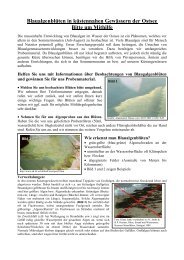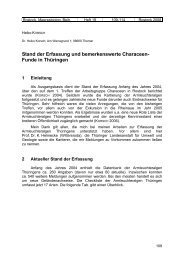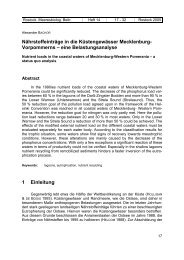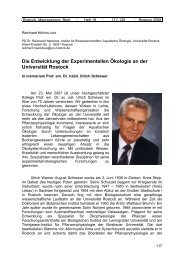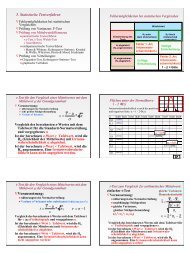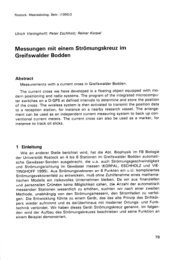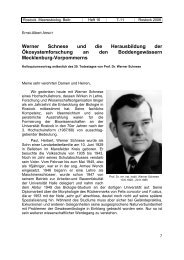Species and synonym list of the German marine - Institut für ...
Species and synonym list of the German marine - Institut für ...
Species and synonym list of the German marine - Institut für ...
You also want an ePaper? Increase the reach of your titles
YUMPU automatically turns print PDFs into web optimized ePapers that Google loves.
Introduction<br />
Salinity <strong>and</strong> its variability, substrate availability <strong>and</strong> light climate are <strong>the</strong> key<br />
factors governing <strong>the</strong> distribution <strong>of</strong> macrophyte species along <strong>the</strong> <strong>German</strong> coast<br />
(LAKOWITZ 1929, KORNMANN & SAHLING 1977, NIELSEN et al. 1995). They can explain<br />
toge<strong>the</strong>r with local hydrodynamic conditions <strong>and</strong> biological factors <strong>the</strong> main portion <strong>of</strong><br />
species distribution (BUCAS et al. 2007).<br />
In <strong>the</strong> last decades changes in distribution <strong>and</strong> diversity <strong>of</strong> macroalgae were<br />
observed in <strong>German</strong> coastal waters. All water bodies bordering <strong>the</strong> <strong>German</strong> states,<br />
Lower Saxony, Schleswig-Holstein, Mecklenburg-Western Pommerania <strong>and</strong> <strong>the</strong>ir<br />
corresponding isl<strong>and</strong>s have been subjected to extremely high anthropogenic impacts<br />
in <strong>the</strong> 20th century (ŁYSIAK-PASTUSZAK 2000; REISE et al. 2006). The nutrient input to<br />
<strong>the</strong> coastal waters is high, especially via rivers <strong>and</strong> diffuse agricultural run-<strong>of</strong>f<br />
(BEHRENDT et al., 1999; STALNACKE et al. 1999). Consequently, <strong>the</strong> trophic status has<br />
increased drastically during <strong>the</strong> last thirty years according to long-term monitoring<br />
measurements (Nausch et al. 1999). The underwater light regime as well as <strong>the</strong><br />
substrate type have changed over time depending on <strong>the</strong> eutrophication <strong>of</strong> <strong>the</strong> water<br />
bodies (SCHUBERT & FORSTER, 1997; NIELSEN et al. 2002). Both factors are important<br />
for <strong>the</strong> composition <strong>and</strong> depth distribution <strong>of</strong> submerged macrophyte communities<br />
(Van den Berg et al. 1998; GREVE & KRAUSE-JENSEN 2005; HAUXWELL et al. 2006) <strong>and</strong><br />
explain observed changes in all regions.<br />
The arrival <strong>of</strong> new species from warmer regions <strong>and</strong> <strong>the</strong> invasion <strong>of</strong> alien<br />
species due to human activities can increase species diversity on <strong>the</strong> one h<strong>and</strong>, but<br />
risk dramatic changes in community structure on <strong>the</strong> o<strong>the</strong>r. Climate change<br />
enhances <strong>the</strong> arrival <strong>of</strong> new species from warmer regions that formerly were not able<br />
to survive. As <strong>the</strong> worldwide transport <strong>of</strong> merch<strong>and</strong>ise on <strong>the</strong> oceans is steadily<br />
increasing, so, too, is <strong>the</strong> transport <strong>of</strong> macroalgae spores <strong>and</strong> juvenile stages in <strong>the</strong><br />
ballast water. Two o<strong>the</strong>r vectors related to <strong>the</strong> arrival <strong>of</strong> alien species are aquaculture<br />
farming <strong>and</strong> unfortunately also <strong>the</strong> escape <strong>of</strong> material from scientific research. Known<br />
alien species from <strong>German</strong> coastal waters can form mono-specific st<strong>and</strong>s in <strong>the</strong><br />
invaded habitats, potentially with persistent impact on <strong>the</strong> native assemblage<br />
structure.<br />
The aim <strong>of</strong> this work was <strong>the</strong> publication <strong>of</strong> a complete check-<strong>list</strong> <strong>and</strong> <strong>synonym</strong><br />
<strong>list</strong> for <strong>marine</strong> <strong>and</strong> brackish macroalgae for <strong>German</strong>y including all invasive species<br />
encountered during <strong>the</strong> last century as a basis for fur<strong>the</strong>r research. We disclaim in<br />
this publication any risk analysis for <strong>German</strong> macroalgae because this was already<br />
done by SCHORIES et al. (1995) <strong>and</strong> is under current revision by <strong>the</strong> <strong>German</strong> Federal<br />
Agency for Nature Conservation (Bundesamt <strong>für</strong> Naturschutz, BfN).<br />
1 Study Area <strong>and</strong> Methods<br />
North <strong>German</strong>y is bordered on its Western side with <strong>the</strong> North Sea <strong>and</strong> on its<br />
Eastern side with <strong>the</strong> brackish Baltic Sea. This geographical feature results in a<br />
variety <strong>of</strong> water bodies, differing in macroalgae richness. Detailed description about<br />
different water typologies for <strong>the</strong> North <strong>and</strong> Baltic Sea are given by GOSSELCK et al.<br />
(2003). Due to <strong>the</strong> lack <strong>of</strong> distribution data for <strong>marine</strong> macrophytes we distinguish<br />
here only between (1) <strong>the</strong> Eastern Frisian Wadden Sea, (2) <strong>the</strong> Nor<strong>the</strong>rn Frisian<br />
Wadden Sea, (3) <strong>the</strong> area around <strong>the</strong> Isl<strong>and</strong> <strong>of</strong> Helgol<strong>and</strong>, (4) <strong>the</strong> Western <strong>German</strong><br />
Baltic Sea from Flensburg to <strong>the</strong> isl<strong>and</strong> <strong>of</strong> Fehmarn <strong>and</strong> (5) <strong>the</strong> Eastern <strong>German</strong><br />
8


